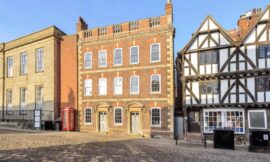Whitby’s 199 Steps, also known as the Church Steps, are a historic and iconic staircase that climbs the steep slope from the town of Whitby in North Yorkshire, England, to St. Mary’s Church and Whitby Abbey atop the East Cliff. This famous stairway has long been a symbol of Whitby’s rich history and dramatic coastal landscape, attracting visitors from far and wide to climb its ancient steps and take in the breathtaking views.
The origin of the 199 Steps dates back centuries, with the first recorded mention of the staircase dating to the 15th century. Originally built to provide access to the parish church of St. Mary, which sits atop the cliff, the steps have been traversed by countless pilgrims, worshippers, and visitors over the centuries.
The steps are constructed of weathered stone and are relatively narrow, winding their way up the steep incline in a series of switchbacks. As visitors ascend the staircase, they are treated to stunning views of Whitby Harbour, the town below, and the North Sea stretching out to the horizon.
At the top of the steps stands St. Mary’s Church, a beautiful medieval parish church that dates back to the 12th century. The church is known for its distinctive octagonal spire and its historic connections to the town’s maritime past. Inside, visitors can explore the ancient interior, admire the intricate stained glass windows, and learn about the church’s fascinating history.
Beyond St. Mary’s Church lies Whitby Abbey, one of the most iconic and evocative ruins in England. Perched on the East Cliff overlooking the town, the abbey dates back to the 7th century and has played a significant role in the history and culture of Whitby. Visitors can explore the atmospheric ruins, learn about the abbey’s storied past, and enjoy panoramic views of the surrounding coastline.
The 199 Steps have captured the imagination of artists, writers, and filmmakers over the years, featuring prominently in literature, art, and popular culture. Perhaps most famously, the steps are mentioned in Bram Stoker’s classic novel “Dracula,” where they serve as the setting for the arrival of the eponymous vampire in England.
Today, the 199 Steps continue to be a popular tourist attraction, drawing visitors from around the world who come to climb the ancient staircase and experience the beauty and history of Whitby. Whether admired for their architectural significance, their stunning views, or their literary connections, the steps remain an enduring symbol of the town’s charm and character.



